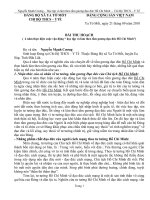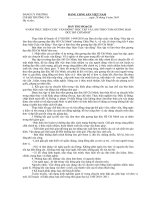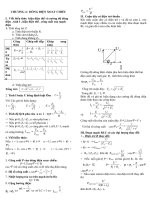Dessler ch 4 job anlysis
Bạn đang xem bản rút gọn của tài liệu. Xem và tải ngay bản đầy đủ của tài liệu tại đây (726.72 KB, 44 trang )
Gary Dessler
tenth edition
Chapter 4
Part 2 Recruitment and Placement
Job Analysis
© 2005 Prentice Hall Inc.
All rights reserved.
PowerPoint Presentation by Charlie Cook
The University of West Alabama
The Nature of Job Analysis
Job analysis
– The procedure for determining the duties and skill
requirements of a job and the kind of person who
should be hired for it.
Job description
– A list of a job’s duties, responsibilities, reporting
relationships, working conditions, and supervisory
responsibilities—one product of a job analysis.
Job specifications
– A list of a job’s “human requirements,” that is, the
requisite education, skills, personality, and so on—
another product of a job analysis.
© 2005 Prentice Hall Inc.
All rights reserved.
4–2
Types of Information Collected
Work activities- how, why, when they are performed
Human behaviors- what are the expectations
Mach., tools, equip.,& wk. aids- services to be used
Performance standards- require. for each job duty
Job context- what is needed; physical wk conditions,sch.
Human requirements- skills, edu, experience, etc
© 2005 Prentice Hall Inc.
All rights reserved.
4–3
Uses of Job Analysis Information
Recruitment and Selection- job descript/ specs
Compensation- total comp package
Performance Appraisal- compares perf. to expectations
Training- skills that are required
Discovering Unassigned Duties- activity w/o resp.
EEO Compliance- does the job meet the stds
© 2005 Prentice Hall Inc.
All rights reserved.
4–4
Uses of Job Analysis Information
© 2005 Prentice Hall Inc.
All rights reserved.
Figure 4–1
4–5
Steps in Job Analysis
Step 1:
Decide how you’ll use the
information.(write, compare, redefine, start new)
Step 2:
Review relevant background
information.(org charts, process job flow, etc)
Step 3:
Select representative positions.(sample)
Step 4:
Actually analyze the job.(# of EE, wk cond’t)
Step 5:
Verify the job analysis information.(w/ EE)
Step 6:
Develop a job description and job
specification.(s/b 2 separate documents)
© 2005 Prentice Hall Inc.
All rights reserved.
4–6
Charting the Organization
Organization chart
– A chart that shows the organizationwide
distribution of work, with titles of each position
and interconnecting lines that show who reports
to and communicates to whom.
Process chart
– A work flow chart that shows the flow of inputs to
and outputs from a particular job.
© 2005 Prentice Hall Inc.
All rights reserved.
4–7
Process Chart for Analyzing a Job’s Workflow
© 2005 Prentice Hall Inc.
All rights reserved.
Figure 4–2
4–8
Methods of Collecting Job Analysis
Information: The Interview
Information sources
– Individual employees
– Groups of employees
– Supervisors with
knowledge of the job
– Terminated EE
Interview formats
– Structured (Checklist)
– Unstructured
Advantages
– Quick, direct way to
find overlooked
information.
Disadvantages
Distorted
information
© –2005
Prentice
Hall Inc.
All rights reserved.
4–9
TYPICAL QUESTIONS
What is the job being performed
What are the major duties of the job
What other locations do you work in
What are the education, skills, certification/ licensing
requirements
What activities do you participate
What are the jobs responsibilities/ duties
What are the basic accountabilities/ performance stds
What are your responsibilities
What are your working conditions
What are the jobs physical, emotional or mental demands
What are the health and safety conditions
© 2005 Prentice Hall Inc.
All rights reserved.
4–10
Interview Guidelines
The job analyst and supervisor should work together
to identify the workers who know the job best.
Quickly establish rapport with the interviewee.
Follow a structured guide or checklist, one that lists
open-ended questions and provides space for
answers.
Ask the worker to list his or her duties in order of
importance and frequency of occurrence.
After completing the interview, review and verify the
data.
© 2005 Prentice Hall Inc.
All rights reserved.
4–11
Methods of Collecting Job Analysis
Information: Questionnaires
Information source
– Have employees fill out
questionnaires to
describe their jobrelated duties and
responsibilities.
Questionnaire formats
– Structured checklists
– Opened-ended
questions
© 2005 Prentice Hall Inc.
All rights reserved.
Advantages
– Quick and efficient way
to gather information
from large numbers of
employees
Disadvantages
– Expense and time
consumed in preparing
and testing the
questionnaire
4–12
Methods of Collecting Job Analysis
Information: Observation
Information source
– Observing and noting
the physical activities
of employees as they
go about their jobs.
Advantages
– Provides first-hand
information
– Reduces distortion of
information
Disadvantages
© 2005 Prentice Hall Inc.
All rights reserved.
– Time consuming
– Difficulty in capturing
entire job cycle
– Of little use if job
involves a high level of
mental activity.
4–13
Methods of Collecting Job Analysis
Information: Participant Diary/Logs
Information source
– Workers keep a
chronological diary/ log
of what they do and
the time spent in each
activity.
© 2005 Prentice Hall Inc.
All rights reserved.
Advantages
– Produces a more
complete picture of the
job
– Employee participation
Disadvantages
– Distortion of
information
– Depends upon
employees to
accurately recall their
activities
4–14
Quantitative Job Analysis Techniques
The position analysis questionnaire (PAQ)
– A questionnaire used to collect quantifiable data
concerning the duties and responsibilities of
various jobs.
The Department of Labor (DOL) procedure
– A standardized method by which different jobs
can be quantitatively rated, classified, and
compared.
Functional job analysis
– Takes into account the extent to which
instructions, reasoning, judgment, and
mathematical and verbal ability are necessary for
performing job tasks.
SEE FORMS ON PP 118 - 124
© 2005 Prentice Hall Inc.
All rights reserved.
4–15
Sample Report
Based on
Department of
Labor Job
Analysis
Technique
(P 124)
© 2005 Prentice Hall Inc.
All rights reserved.
Figure 4–6
4–16
Writing Job Descriptions
A job description
– A written statement of what the worker actually
does, how he or she does it, and what the job’s
working conditions are.
Sections of a typical job description
– Job identification
– Job summary
– Responsibilities and duties
– Authority of incumbent
– Standards of performance
– Working conditions
– Job specifications
© 2005 Prentice Hall Inc.
All rights reserved.
4–17
Sample Job
Description,
Pearson
Education
(P 126 – 127)
© 2005 Prentice Hall Inc.
All rights reserved.
Source: Courtesy of HR Department,
Pearson Education.
Figure 4–7a
4–18
Sample Job
Description,
Pearson
Education
© 2005 Prentice Hall Inc.
All rights reserved.
Source: Courtesy of HR
Department, Pearson
Education.
Figure 4–7b
4–19
“Marketing Manager” Description
from
Standard Occupational Classification
20. 11-2021 Marketing Managers
Abstract: 11-2021 Marketing Managers. Determine the demand
for products and services offered by a firm and Its competitors and
identify potential customers. Develop pricing strategies with the
goal of maximizing the firm’s profits or share of the market while
ensuring the firm’s customers are satisfied.
© 2005 Prentice Hall Inc.
All rights reserved.
Source: www.bis.gov, accessed November 13, 2003.
Figure 4–8
4–20
The Job Description
Job identification
– Job title: name of job
– FLSA status section: Exempt or nonexempt
– Preparation date: when the description was
written
– Prepared by: who wrote the description
– Location of the job
– Information regarding salary/ pay scale
Job summary
– Describes the general nature of the job
– Lists the major functions or activities (be specific;
not “other duties”)
© 2005 Prentice Hall Inc.
All rights reserved.
4–21
The Job Description (cont’d)
Relationships (chain of command)
– Reports to: employee’s immediate supervisor
– Supervises: employees that the job incumbent
directly supervises
– Works with: others with whom the job holder will
be expected to work and come into contact with
internally.
– Outside the company: others with whom the job
holder is expected to work and come into contact
with externally.
© 2005 Prentice Hall Inc.
All rights reserved.
4–22
The Job Description (cont’d)
Responsibilities and duties
– A listing of the job’s major responsibilities and
duties (essential functions)
– Defines limits of jobholder’s decision-making
authority, direct supervision, and budgetary
limitations.
Standard Occupational Classification
– Classifies all workers into one of 23 major groups
of jobs which are subdivided into 96 minor groups
of jobs and detailed occupations.
© 2005 Prentice Hall Inc.
All rights reserved.
4–23
SOC’s
Major
Groups of
Jobs
© 2005 Prentice Hall Inc.
All rights reserved.
Note: Within these major groups
are 96 minor groups, 449 broad
occupations, and 821 detailed
occupations.
Table 4–2
4–24
Is the Job Function Essential?
What three or four main activities actually constitute the job? Is
each really necessary?
What is the relationship between each task? Is there a special
sequence which the tasks must follow?
Do the tasks necessitate sitting, standing, crawling, walking,
climbing, running, stooping, kneeling, lifting, carrying, digging,
writing, operating, pushing, pulling, fingering, talking, listening,
interpreting, analyzing, seeing, coordinating, etc.?
How many employees are available to perform the job function?
Can the job function be distributed among other employees?
How much time is spent on the job performing each particular
function? Are infrequent tasks less important to success?
Would removing a function fundamentally alter the job?
© 2005 Prentice Hall Inc.
All rights reserved.
4–25









